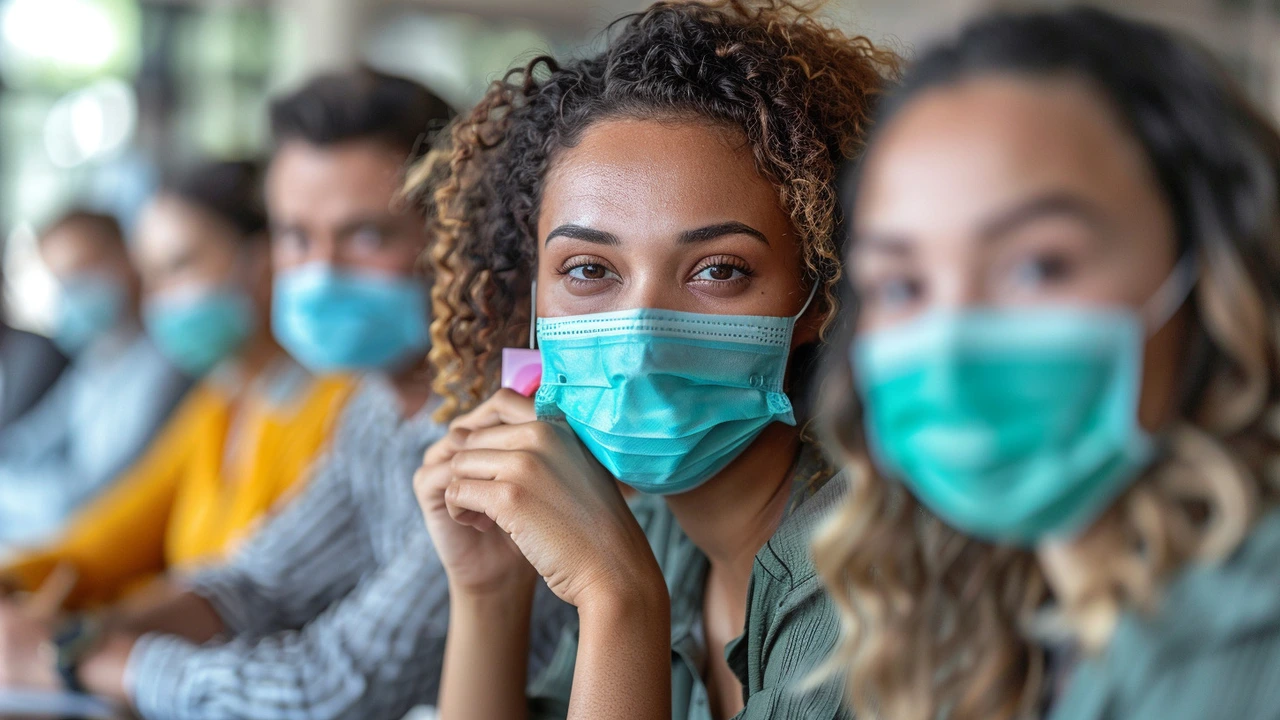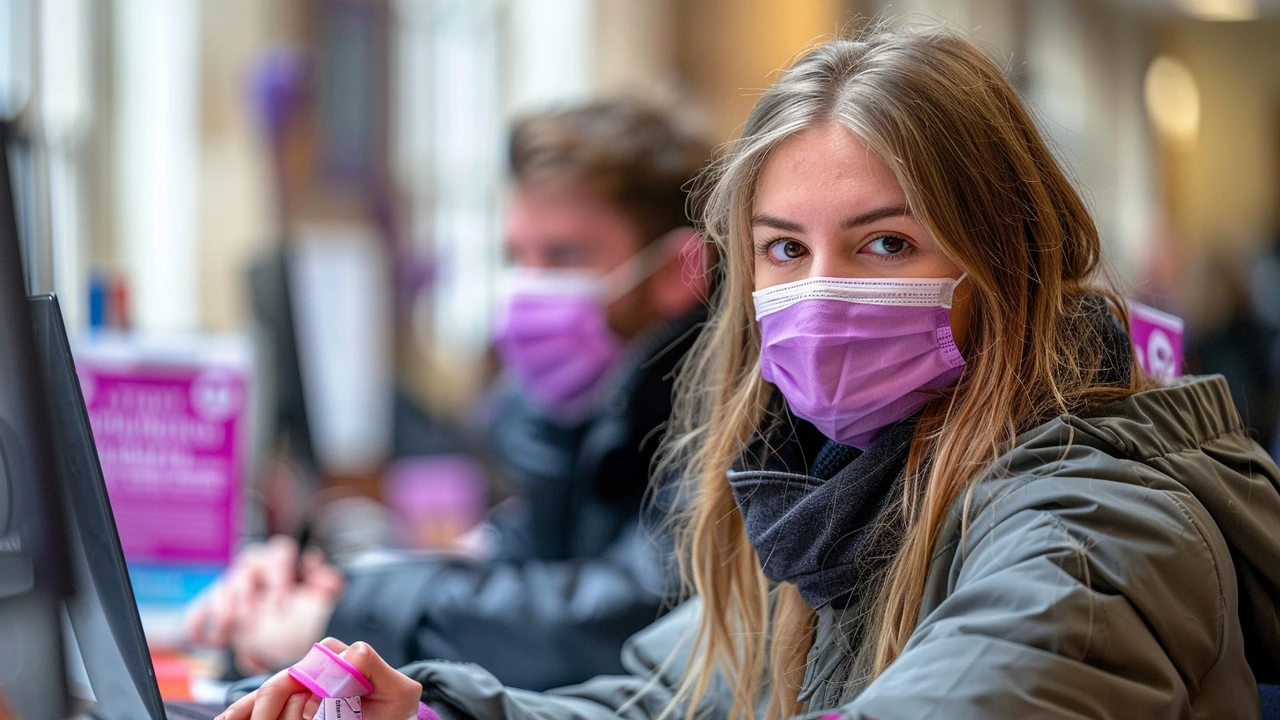Everyone knows that no matter the season, someone at work is likely to cough at some point. This simple act, while often harmless, can be a nightmare for spreading germs across the office. The key to a healthier workplace lies in understanding how germs travel and implementing effective measures to halt their journey.
Exploring the nature of germs, the importance of proper hand hygiene, and the etiquette of coughing and sneezing can make a world of difference. Also, maintaining clean workspaces and encouraging policies where sick employees can stay home further minimizes the risk of illnesses spreading. By promoting a culture of health and wellness, offices can become safer and more comfortable places to work.
- Understanding Germs and How Coughs Spread Them
- Importance of Hand Hygiene
- Proper Coughing and Sneezing Etiquette
- Cleaning and Sanitizing Workspaces
- Encouraging Sick Employees to Stay Home
- Promoting a Healthy Office Environment
Understanding Germs and How Coughs Spread Them
Germs are everywhere, and they come in all shapes and sizes. The culprits behind many common illnesses include bacteria, viruses, and fungi. These microscopic invaders can quickly spread from person to person, creating a cascade of infection within a close-knit environment like an office. Understanding how coughs contribute to this process is key to stopping their spread.
When someone coughs, they release tiny droplets into the air that can contain all sorts of nasty pathogens. These droplets can travel up to 6 feet and settle on surfaces or be inhaled by others nearby. This is why it’s so important to cover your mouth when you cough and to keep your hands clean. It's also why shared items like keyboards, phones, and door handles can become hotspots for germs if not regularly disinfected.
The nature of germs means they are often invisible to the naked eye, which can give a false sense of security. Studies have shown that flu viruses, for example, can survive on hard surfaces for up to 48 hours. Let that sink in. An innocent touch of a desk followed by rubbing your eyes or eating can make you sick. This explains why understanding and maintaining hygiene protocols is crucial in a workplace.
“Germs spread through touch, droplets, and even the very air we breathe. Following simple hygiene rules can prevent most infections.” - Dr. Lisa Ackerley, The Hygiene Doctor
Viruses are particularly adept at finding new hosts. The common cold and influenza viruses are spread predominantly through respiratory droplets. A single cough can release thousands of droplets, each potentially carrying disease. The ease of transmission is why offices can sometimes feel like incubators once one person falls ill. Temperature, humidity, and air circulation within workplaces can also influence the survival and spread of these germs.
Another aspect to consider is that not all illnesses manifest symptoms immediately. People can be contagious before they even know they are sick, unknowingly spreading germs around. This is particularly true for viral infections such as the flu or COVID-19. Understanding this facet of germ science supports initiatives for regular sanitation and personal hygiene, even when everyone appears healthy.
Aiding the spread of germs is also the way humans interact socially. Handshakes, shared cups at the coffee machine, touching communal buttons on printers, all of these are pathways for pathogenic travel. By fostering a culture of individual responsibility and collective care, where simple actions like using tissues, hand sanitizers, and disinfecting surfaces are standard, offices can drastically reduce the spread of germs caused by coughs.
Importance of Hand Hygiene
The simple act of washing your hands can be a game-changer in combating the spread of germs, especially in a shared environment like a workplace. Clean hands are crucial for preventing infections as they reduce the possibility of transferring viruses and bacteria from one surface to another or from person to person. Recent studies highlight that proper hand hygiene can cut respiratory illnesses by 16-21%, proving just how effective this practice can be.
It's recommended to wash your hands for at least 20 seconds. This is about the time it takes to hum the 'Happy Birthday' song twice. Make sure to pay attention to all hand surfaces, including the back of your hands, between fingers, and under nails. If soap and water are not readily available, using a hand sanitizer with at least 60% alcohol is a good alternative. Hand sanitizer should cover all surfaces of your hands and be rubbed together until they feel dry. Quick and careless washing or sanitizing is useless.
"Hand hygiene is the single most important measure to prevent the transmission of bacteria and viruses," echoes the Centers for Disease Control and Prevention (CDC).
Office settings often have high-touch surfaces such as door handles, elevator buttons, and shared equipment like printers or coffee machines. These can be hotspots for germs. Regular and thorough cleaning of these surfaces, along with frequent hand washing after contact, is essential. Awareness and consistent habits are key. Encouraging a routine of hand grooming can lead to fewer sick days and a healthier workforce. Visual reminders can be very effective. Posters near sinks and hand sanitizer dispensers promote a consciousness of hand hygiene.
In addition, sharing knowledge and cultivating good hand hygiene practices is fundamental. Organize short workshops or informational sessions to demonstrate the correct way to wash hands. Provide employees with easy access to the necessary facilities - make sure bathrooms and kitchen areas are stocked with soap, hand sanitizers, and clean towels or tissues. By emphasizing the importance of hand hygiene, and providing the means to practice it, you create a workspace that looks out for everyone's health and safety. With these steps, maintaining workplace health becomes a shared responsibility.

Proper Coughing and Sneezing Etiquette
Ensuring proper coughing and sneezing etiquette in the workplace is crucial in curbing the spread of germs. The basic principle to remember is to minimize droplets flying through the air, which can carry bacteria and viruses. A good practice is to always use a tissue or your elbow when coughing or sneezing. This simple habit significantly reduces the chance of spreading germs to nearby surfaces or colleagues. Carrying disposable tissues with you and disposing of them immediately after use can make a world of difference.
If you don't have a tissue handy, coughing or sneezing into the crook of your elbow is a safe alternative. This method prevents germs from landing on your hands, which are more likely to touch and contaminate common surfaces. It might feel awkward at first, but it soon becomes second nature with time. The Centers for Disease Control and Prevention recommends this practice for effective germ control.
It is also important to recognize the power of hand hygiene. After coughing or sneezing, always wash your hands with soap and water or use an alcohol-based hand sanitizer if a sink isn't nearby. Thorough handwashing for at least 20 seconds can eliminate most of the germs. Make sure to clean the back of your hands, between your fingers, and under your nails for the best results.
According to Dr. William Schaffner, an infectious disease specialist, "Proper cough etiquette can help to curtail the spread of infections that cost businesses millions each year in lost productivity".
Additionally, being mindful of your surroundings when you're about to cough or sneeze can protect others. If you feel a sneeze or cough coming on, try to turn away from your coworkers and direct it into your elbow or a tissue. This action shows respect for those around you and keeps communal areas cleaner.
Encouraging proper coughing and sneezing etiquette can be made easier by putting up reminder signs in common areas like break rooms and restrooms. Office managers can also provide hand sanitizers and tissues in accessible locations to promote better hygiene practices. Shaping such behavior doesn't only help in preventing regular illnesses but also prepares the office for more severe outbreaks, ensuring a prudent approach to public health in a shared environment.
Making sure everyone understands and follows these protocols can help reduce absenteeism and maintain overall well-being in the office. Educate employees about the importance of these steps through meetings or email reminders. This collective effort will make a significant impact on office health. Proper etiquette isn't just about protecting yourself; it's about being considerate of your coworkers' health and creating a safer workplace for everyone.
Cleaning and Sanitizing Workspaces
A healthy workplace isn't just about personal habits; it equally depends on the cleanliness of the environment. Properly cleaning and sanitizing workspaces is crucial to prevent the spread of germs. Many might be unaware, but germs can survive on surfaces like desks and keyboards for several hours, if not days.
Let’s start with the basics: identify the high-touch areas. These are spots people frequently come in contact with, such as door handles, light switches, keyboards, and phones. These surfaces should be cleaned multiple times a day using disinfectant wipes or sprays. A quick wipe isn’t enough; the surface must stay wet for a few minutes to ensure germs are killed.
Besides high-touch areas, communal spaces like kitchens and break rooms need extra attention. These are hotbeds for germ transfer. Make it a routine to disinfect these places daily. Provide cleaning supplies so everyone can wipe down anything after they use it. Educating employees about these practices helps maintain collective responsibility for cleanliness.
There's a difference between cleaning and sanitizing. Cleaning removes dirt and some germs, but sanitizing kills most of the germs on a surface. It's essential to do both for an effective defense against illness. Regular cleaning followed by sanitizing ensures that workspaces stay as germ-free as possible.
Encouraging employees to keep their personal work areas tidy also aids in this battle. A clutter-free desk is easier to clean and less likely to harbor hidden germs. It might be helpful to set reminders or have scheduled cleaning times where everyone takes a few minutes to clean their spaces.
Using air purifiers can also help reduce the number of airborne germs. While cleaning surfaces is critical, don’t overlook the air quality in the workspace. Good ventilation and regularly maintained air filters can significantly lower the chances of illnesses spreading through coughs and sneezes.
As Dr. Susan Whittier from Columbia University Medical Center says, "In high-traffic office areas, germs can quickly become a widespread problem. Regular and thorough cleaning and sanitizing are among the most effective methods for preventing their spread."
Lastly, don't forget about digital devices. Phones and tablets are often overlooked but can be breeding grounds for bacteria. Encourage everyone to clean their devices daily with wipes that are safe for electronics. By integrating these practices into the daily routine, we can create a healthier and more hygienic work environment for everyone.

Promoting a Healthy Office Environment
Creating a healthy office environment is vital for reducing the spread of germs. A crucial step is ensuring that the air quality is good. Poor ventilation can lead to an accumulation of germs, so it's important to have an effective HVAC system that’s regularly maintained. You can consider adding air purifiers to common areas. They can help to remove contaminants from the air, providing a cleaner breathing environment for everyone.
In addition to the air quality, the promotion of good hygiene practices among staff is essential. It’s beneficial to have posters around the office reminding everyone of the importance of washing hands regularly. Hand sanitizing stations should be readily available, especially in high-traffic areas like entrances and common rooms. Educating staff about the correct way to wash hands and use sanitizers ensures that everyone does their part in keeping the workplace germ-free.
Another effective strategy is to create policies that encourage sick employees to stay home. Often, people feel compelled to come to work when they are unwell, fearing they'll fall behind or out of a sense of obligation. A policy that supports sick leave can help mitigate this concern. By ensuring that employees do not suffer consequences for staying home when sick, you prevent the potential spread of illnesses in the office.
According to a study by the CDC, offices with strict sick leave policies saw a 20% decrease in workplace illness outbreaks.
Regular cleaning and disinfecting are also fundamental to a healthy office environment. Have a professional cleaning service that comes in at least once a week to perform a deep clean. In between professional cleanings, encourage employees to wipe down their workspaces with disinfectant wipes. Shared equipment like phones, keyboards, and printers should be cleaned regularly to eliminate the risk of transmission through surfaces.
Encourage a culture of health by introducing wellness programs. Activities such as flu vaccinations, yoga classes, and healthy eating workshops can be both fun and educational. These programs not only promote physical health but also contribute to mental well-being. Healthier, happier employees are more productive and less likely to spread germs.
Creating a Community of Care
Beyond physical measures, fostering a sense of community and care amongst employees is vital. When everyone feels responsible for each other’s well-being, they are more likely to follow health guidelines. Organize regular team meetings to discuss health and hygiene, making it a shared responsibility.
Finally, lead by example. Management should visibly adhere to these health practices. When leaders demonstrate the importance of cleaning, sanitizing, and staying home when sick, employees are more likely to follow suit. The road to a healthier office environment starts with every individual playing their part.

Sharon Campbell
June 23, 2024 AT 12:40sara styles
June 23, 2024 AT 13:59Brendan Peterson
June 24, 2024 AT 20:33Jessica M
June 25, 2024 AT 19:57Erika Lukacs
June 26, 2024 AT 02:46Rebekah Kryger
June 27, 2024 AT 16:52Victoria Short
June 29, 2024 AT 12:00Jennifer Stephenson
June 29, 2024 AT 16:19Segun Kareem
July 1, 2024 AT 11:22Philip Rindom
July 2, 2024 AT 21:29Jess Redfearn
July 4, 2024 AT 15:16Ashley B
July 6, 2024 AT 08:33Scott Walker
July 7, 2024 AT 07:22Eric Gregorich
July 7, 2024 AT 16:39Koltin Hammer
July 9, 2024 AT 05:33